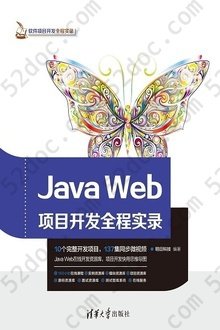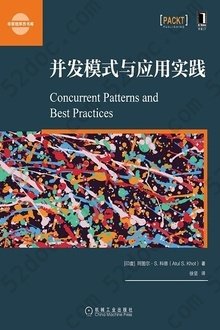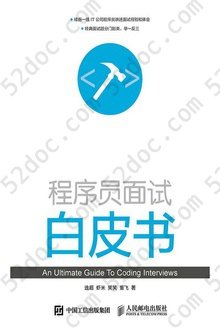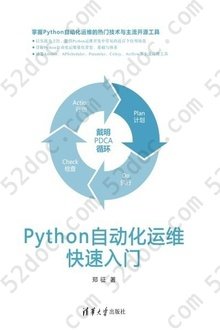注重体验与质量的电子书资源下载网站
分类于: 人工智能 其它
简介
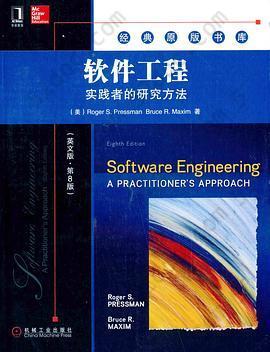
软件工程:实践者的研究方法(英文版)(第8版) 豆 0.0分
资源最后更新于 2020-08-19 16:10:02
作者:Roger S.Pressman
出版社:机械工业出版社
出版日期:2015-01
ISBN:9787111489504
文件格式: pdf
标签: 软件开发 CS 项目管理 软件工程 大学计算机 ComputerScience
简介· · · · · ·
《软件工程:实践者的研究方法(英文版)(第8版)》内容做了如下划分:第一部分软件过程,介绍说明性模型和敏捷过程模型。第二部分建模,介绍现代分析与设计方法,重点放在基于UML的建模上。第三部分质量管理,描述软件测试和质量保证、形式化验证技术和变更管理的各个方面。第四部分软件项目管理,介绍与计划、管理和控制软件项目有关的主题。第五部分软件工程高级课题,讲述软件过程改进及软件工程的发展趋势。
目录
Preface
CHAPTER 1 THE NATURE OF SOFTWARE
1.1 The Nature of Software
1.1.1 Defininq Software
1.1.2 Software Application Domains
1.1.3 Legacy Software
1.2 The Changing Nature of Software
1.2.1 WebApps
1.2.2 Mobile Applications
1.2.3 Cloud Computing
1.2.4 Product Line Software
1.3 Summary
PROBIEMS AND POINTS TO PONDER
FURTHER READINGS AND INFORMATION SOURCES
CHAPTER 2 SOFTWARE ENGINEERING
2.1 Defining the Discipline
2.2 The Software Process
2.2.1 The Process Framework
2.2.2 Umbrella Activities
2.2.3 Process Adaptation
2.3 Software Engineering Practice
2.3.1 The Essence of Practice
2.3.2 General Principles
2.4 Software Development Myths
2.5 How It All Starts
2.6 Summary
PROBIEMS AND POINTS TO PONDER
FURTHER READINGS AND INFORMATION SOURCES
PART ONE THE SOFTWARE PROCESS
CHAPTER 3 SOFTWARE PROCESS STRUCEURE
3.1 A Generic Process Model
3.2 Defining a Framework Activity
3.3 Identifying a Task Set
3.4 Process Patterns
3.5 Process Assessment and Improvement
36 Surnmary
PROBLEMS AND POINTS TO PONDER
FURTHER READINGS AND INFORMATION SOURCES
CHAPTER 4 PROCESS MODELS
4.1 Prescriptive Process Models
4.1.1 The Waterfall Model
4.1.2 Incremental Process Models
4.1.3 Evolutionary Process Models
4.1.4 Concurrent Models
4.1.5 A Final Word on Evolutionary Processes
4.2 Specialized Process Models
4.2.1 Componenr—Based Development
4.2.2 The Formal Methods Model
4.2.3 Aspect—Oriented Software Developmenl
4.3 The Unified Process
4.3.1 A Brief History
4.3.2 Phases of the Unified Process
4.4 Personal and Team Process Models
4.4.1 Personal Software Process
4.4.2 Team Software Process
4.5 Process Technology
4.6 Product and Process
4.7 Summary
PROBLEMS AND POIHTS TO PONDER
FURTHER READINGS AND INFORMATION SOURCES
CHAPTER 5 AGILS DEVELOPMENT
5.1 What Is Agility?
5.2 Agility and the Cost of CHange
5.3 What Is an Agile Process?
5.3.1 Agility Principles
5.3.2 The Politics of Agile Development
5.4 Extreme Programming
5.4.1 The XP Process
5.4.2 Industrial XP
5.5 Other Agile Process Modeis
5.5.1 Scrum
5.5.2 Dynamic Systems Development Method
5.5.3 Agile Modeling
5.5.4 Agile Unified Process
5.6 A Tool Set for tHe Agile Process
5.7 Summary
PROBLEMS AND POINTS TO PONDER
FURTHER READINGS AND INFORMATION SOURCES
CHAPTER 6 HUMAN ASPECTS OF SOFTWARE ENGINEERING
6.1 Characteristics of a Software Engineer
6.2 The Psychology of Software Engineering
6.3 The Soffware Team
6.4 Team Structures
6.5 Agile Teams
6.5.1 The Generic Agile Team
6.5.2 The XP Team
6.6 The Impad of Social Medio
6.7 Software Engineering Using the Cloud
6.8 Collaboration Tools
6.9 Global Teams
6.10 Summary
PROBLEMS AND POINTS TO PONDER
FURTHER READINGS AND INFORMATION SOURCES
PART TWO MODELING
CHAPTER 7 PRINCIPLES THAT GUIDE PRACTICE
7.1 Software Engineering Knowledge
7.2 Core Principles
7.2.1 Principles That Guide Process
7.2.2 Principles That Guide Practice
7.3 Principles That Guide Each Framework Activicy
7.3.1 Communication Prinaples
7.3.2 Planning Principles
7.3.3 Modeiing Principles
7.3.4 Construdion Principles
7.3.5 Deployment Principles
7.4 Work Practices
7.5 Summary
PROBLEMS AND POINTS TO PONDER
FURTHER READINGS AND INFORMATION SOURCES
CHAPTER 8 UNDERSTANDING REQUIREMENTS
8.1 Requirements Engineering
8.2 Estoblishing the Gfoundwork
8.2.1 Identifying Stakehotders
8.2.2 Recognizing Multiple Viewpoints
8.2.3 Working toword Collaboration
8.2.4 Asking the First Quesfions
8.2.5 Nonfunctional Requirements
8.2.6 Traceability
8.3 Eliciting Requiremenfs
8.3.1 Collaborative Requirements Gathering
8.3.2 Quolity Function Deployment
8.3.3 Usage Scenarios
8.3.4 Elicitation Work Products
8.3.5 Agile Requirements Elicitarion
8.3.6 Service—Oriented Methods
8.4 Developing Use Cases
8.5 Building the Analysis Model
8.5.1 Elements of the Analysis Model
8.5.2 Analysis Potferns
8.5.3 Agile Requirements Engineering
8.5.4 Requirements for Self—Adaptive Systems
8.6 Negotiating Requirements
8.7 Requirements Monitoring
8.8 Validafing Requirements
8.9 Avoiding Common Mistakes
8.10 Summary
PROBLEMS AND POINTS TO PONDER
FURTHER READINGS AND OTHER INFORMATION SOURCES
CHAPTER 9 REQUIREMENTS MODELING: SCENARIO—BASED METHODS
9.1 Requirements Analysis
9.1.1 Overall Objectives and Philosophy
9.1.2 Analysis Rules of Thumb
9.1.3 Domain Analysis
9.1.4 Requirements Modeling Approaches
9.2 Scenario—Based Modeling
9.2.1 Creating o Preliminary Use Case
9.2.2 Refining a Preliminary Use Case
9.2.3 Writing a Formal Use Case
9.3 UML Models That Supplement the Use Case
9.3.1 Developing an Activity Diagram
9.3.2 Swimlone Diagrams
9.4 Summary
PROBLEMS AND POINTS TO PONDER
FURTHER READINGS AND INFORMATION SOURCES
CHAPTER 10 REQUIREMENTS MODELING: CLASS—BASED METHODS
10.1 Identifying Analysis Closses
10.2 Specifying Attributes
10.3 Defining Operations
10.4 Class—Responsibility—Collaborafor Modeling
10.5 Associations and Dependencies
10.6 Analysis Packages
10.7 Summary
PROBLEMS AND POINTS TO PONDER
FURTHER READINGS AND INFORMATION SOURCES
CHAPTER 11 REQUIREMENTS MODELING; BEHAVIOR,PATTERNS,AND WEB/MOBILE APPS
11.1 Creating a Behavioral Model
11.2 Identifying Events with the Use Case
11.3 State Representations
11.4 Patterns for Requirements Modeling
11.4.1 Discovering Analysis Patterns
11.4.2 A Requirements Pattern Example: Actuafor—Sensor
11.5 Requirements Modeling for Web and Mobile Apps
11.5.1 How Much Analysis Is Enough?
11.5.2 Requirements Modeling Input
11.5.3 Requirements Modeling Output
11.54 Contenl Model
11.5.5 Interation Model for Web and Mobile Apps
11.5.6 Functional Model
11.5.7 Configuration Models for WebApps
11.5.8 Navigation Modeling
11.6 Summary
PROBLEMS AND POINTS TO PONDER
FURTHER READINGS AND INFORMATION SOURCES
……
CHAPTER 12 DESIGN CONCEPTS
CHAPTER 13 ARCHITECTURAL DESIGN
CHAPTER 14 COMPONENT—LEVEL DESIGN
CHAPTER 15 USER INTERFACE DESIGN
CHAPTER 16 PATTERN—BASED DESIGN
CHAPTER 17 WEBAPP DESIGN
CHAPTER 18 MOBILEAPP DESIGN
PART THREE QUALITY MANAGEMENT
CHAPTER 19 QUALITY CONCEPTS
CHAPTER 20 REVIEW TECHNIQUES
CHAPTER 21 SOFTWARE QUALITY ASSURANCE
CHAPTER 22 SOFTWARE TESTING STRATEGIES
CHAPTER 23 TESTING CONVENTIONAL APPLICATIONS
CHAPTER 24 TESTING OBJECT—ORIENTED APPLICATIONS
CHAPTER 25 TESTING WEB APPLICATIONS
CHAPTER 1 THE NATURE OF SOFTWARE
1.1 The Nature of Software
1.1.1 Defininq Software
1.1.2 Software Application Domains
1.1.3 Legacy Software
1.2 The Changing Nature of Software
1.2.1 WebApps
1.2.2 Mobile Applications
1.2.3 Cloud Computing
1.2.4 Product Line Software
1.3 Summary
PROBIEMS AND POINTS TO PONDER
FURTHER READINGS AND INFORMATION SOURCES
CHAPTER 2 SOFTWARE ENGINEERING
2.1 Defining the Discipline
2.2 The Software Process
2.2.1 The Process Framework
2.2.2 Umbrella Activities
2.2.3 Process Adaptation
2.3 Software Engineering Practice
2.3.1 The Essence of Practice
2.3.2 General Principles
2.4 Software Development Myths
2.5 How It All Starts
2.6 Summary
PROBIEMS AND POINTS TO PONDER
FURTHER READINGS AND INFORMATION SOURCES
PART ONE THE SOFTWARE PROCESS
CHAPTER 3 SOFTWARE PROCESS STRUCEURE
3.1 A Generic Process Model
3.2 Defining a Framework Activity
3.3 Identifying a Task Set
3.4 Process Patterns
3.5 Process Assessment and Improvement
36 Surnmary
PROBLEMS AND POINTS TO PONDER
FURTHER READINGS AND INFORMATION SOURCES
CHAPTER 4 PROCESS MODELS
4.1 Prescriptive Process Models
4.1.1 The Waterfall Model
4.1.2 Incremental Process Models
4.1.3 Evolutionary Process Models
4.1.4 Concurrent Models
4.1.5 A Final Word on Evolutionary Processes
4.2 Specialized Process Models
4.2.1 Componenr—Based Development
4.2.2 The Formal Methods Model
4.2.3 Aspect—Oriented Software Developmenl
4.3 The Unified Process
4.3.1 A Brief History
4.3.2 Phases of the Unified Process
4.4 Personal and Team Process Models
4.4.1 Personal Software Process
4.4.2 Team Software Process
4.5 Process Technology
4.6 Product and Process
4.7 Summary
PROBLEMS AND POIHTS TO PONDER
FURTHER READINGS AND INFORMATION SOURCES
CHAPTER 5 AGILS DEVELOPMENT
5.1 What Is Agility?
5.2 Agility and the Cost of CHange
5.3 What Is an Agile Process?
5.3.1 Agility Principles
5.3.2 The Politics of Agile Development
5.4 Extreme Programming
5.4.1 The XP Process
5.4.2 Industrial XP
5.5 Other Agile Process Modeis
5.5.1 Scrum
5.5.2 Dynamic Systems Development Method
5.5.3 Agile Modeling
5.5.4 Agile Unified Process
5.6 A Tool Set for tHe Agile Process
5.7 Summary
PROBLEMS AND POINTS TO PONDER
FURTHER READINGS AND INFORMATION SOURCES
CHAPTER 6 HUMAN ASPECTS OF SOFTWARE ENGINEERING
6.1 Characteristics of a Software Engineer
6.2 The Psychology of Software Engineering
6.3 The Soffware Team
6.4 Team Structures
6.5 Agile Teams
6.5.1 The Generic Agile Team
6.5.2 The XP Team
6.6 The Impad of Social Medio
6.7 Software Engineering Using the Cloud
6.8 Collaboration Tools
6.9 Global Teams
6.10 Summary
PROBLEMS AND POINTS TO PONDER
FURTHER READINGS AND INFORMATION SOURCES
PART TWO MODELING
CHAPTER 7 PRINCIPLES THAT GUIDE PRACTICE
7.1 Software Engineering Knowledge
7.2 Core Principles
7.2.1 Principles That Guide Process
7.2.2 Principles That Guide Practice
7.3 Principles That Guide Each Framework Activicy
7.3.1 Communication Prinaples
7.3.2 Planning Principles
7.3.3 Modeiing Principles
7.3.4 Construdion Principles
7.3.5 Deployment Principles
7.4 Work Practices
7.5 Summary
PROBLEMS AND POINTS TO PONDER
FURTHER READINGS AND INFORMATION SOURCES
CHAPTER 8 UNDERSTANDING REQUIREMENTS
8.1 Requirements Engineering
8.2 Estoblishing the Gfoundwork
8.2.1 Identifying Stakehotders
8.2.2 Recognizing Multiple Viewpoints
8.2.3 Working toword Collaboration
8.2.4 Asking the First Quesfions
8.2.5 Nonfunctional Requirements
8.2.6 Traceability
8.3 Eliciting Requiremenfs
8.3.1 Collaborative Requirements Gathering
8.3.2 Quolity Function Deployment
8.3.3 Usage Scenarios
8.3.4 Elicitation Work Products
8.3.5 Agile Requirements Elicitarion
8.3.6 Service—Oriented Methods
8.4 Developing Use Cases
8.5 Building the Analysis Model
8.5.1 Elements of the Analysis Model
8.5.2 Analysis Potferns
8.5.3 Agile Requirements Engineering
8.5.4 Requirements for Self—Adaptive Systems
8.6 Negotiating Requirements
8.7 Requirements Monitoring
8.8 Validafing Requirements
8.9 Avoiding Common Mistakes
8.10 Summary
PROBLEMS AND POINTS TO PONDER
FURTHER READINGS AND OTHER INFORMATION SOURCES
CHAPTER 9 REQUIREMENTS MODELING: SCENARIO—BASED METHODS
9.1 Requirements Analysis
9.1.1 Overall Objectives and Philosophy
9.1.2 Analysis Rules of Thumb
9.1.3 Domain Analysis
9.1.4 Requirements Modeling Approaches
9.2 Scenario—Based Modeling
9.2.1 Creating o Preliminary Use Case
9.2.2 Refining a Preliminary Use Case
9.2.3 Writing a Formal Use Case
9.3 UML Models That Supplement the Use Case
9.3.1 Developing an Activity Diagram
9.3.2 Swimlone Diagrams
9.4 Summary
PROBLEMS AND POINTS TO PONDER
FURTHER READINGS AND INFORMATION SOURCES
CHAPTER 10 REQUIREMENTS MODELING: CLASS—BASED METHODS
10.1 Identifying Analysis Closses
10.2 Specifying Attributes
10.3 Defining Operations
10.4 Class—Responsibility—Collaborafor Modeling
10.5 Associations and Dependencies
10.6 Analysis Packages
10.7 Summary
PROBLEMS AND POINTS TO PONDER
FURTHER READINGS AND INFORMATION SOURCES
CHAPTER 11 REQUIREMENTS MODELING; BEHAVIOR,PATTERNS,AND WEB/MOBILE APPS
11.1 Creating a Behavioral Model
11.2 Identifying Events with the Use Case
11.3 State Representations
11.4 Patterns for Requirements Modeling
11.4.1 Discovering Analysis Patterns
11.4.2 A Requirements Pattern Example: Actuafor—Sensor
11.5 Requirements Modeling for Web and Mobile Apps
11.5.1 How Much Analysis Is Enough?
11.5.2 Requirements Modeling Input
11.5.3 Requirements Modeling Output
11.54 Contenl Model
11.5.5 Interation Model for Web and Mobile Apps
11.5.6 Functional Model
11.5.7 Configuration Models for WebApps
11.5.8 Navigation Modeling
11.6 Summary
PROBLEMS AND POINTS TO PONDER
FURTHER READINGS AND INFORMATION SOURCES
……
CHAPTER 12 DESIGN CONCEPTS
CHAPTER 13 ARCHITECTURAL DESIGN
CHAPTER 14 COMPONENT—LEVEL DESIGN
CHAPTER 15 USER INTERFACE DESIGN
CHAPTER 16 PATTERN—BASED DESIGN
CHAPTER 17 WEBAPP DESIGN
CHAPTER 18 MOBILEAPP DESIGN
PART THREE QUALITY MANAGEMENT
CHAPTER 19 QUALITY CONCEPTS
CHAPTER 20 REVIEW TECHNIQUES
CHAPTER 21 SOFTWARE QUALITY ASSURANCE
CHAPTER 22 SOFTWARE TESTING STRATEGIES
CHAPTER 23 TESTING CONVENTIONAL APPLICATIONS
CHAPTER 24 TESTING OBJECT—ORIENTED APPLICATIONS
CHAPTER 25 TESTING WEB APPLICATIONS




